1996 CHEVROLET CAVALIER service interval
[x] Cancel search: service intervalPage 276 of 372
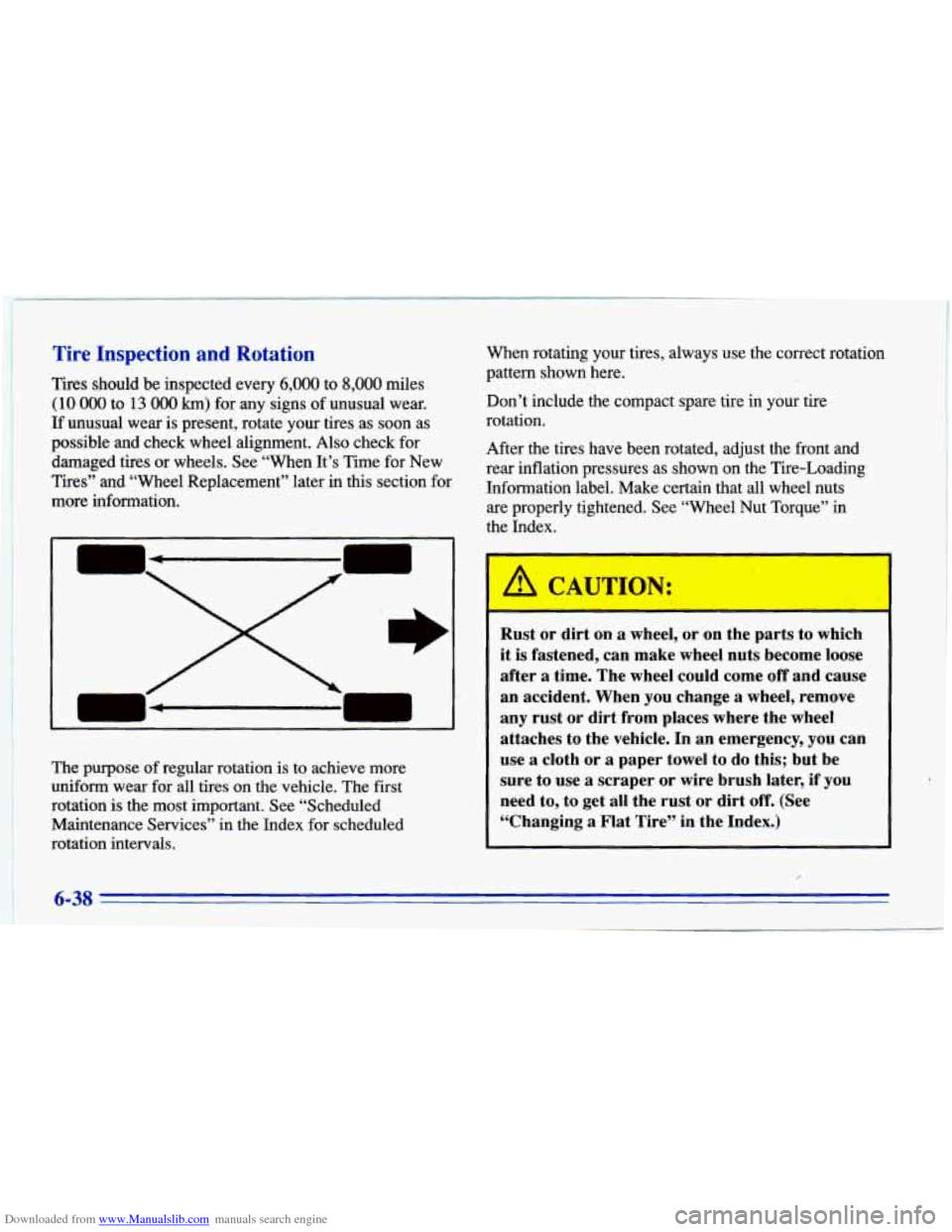
Downloaded from www.Manualslib.com manuals search engine Tire Inspection and Rotation
1 Tires should be inspected every 6,000 to 8,000 miles
(10 000 to 13 000 km) for any signs of unusual wear.
If unusual wear is present, rotate your tires as soon as
possible and check wheel alignment. Also check for
damaged tires or wheels. See “When It’s Time for New
Tires” and “Wheel Replacement” later in this section for
more information.
The purpose of regular rotation is to achieve more
uniform wear for all tires on the vehicle. The first
rotation is the most important. See “Scheduled
Maintenance Services” in the Index for scheduled
rotation intervals. When rotating your tires, always use the Correct rotation
pattern shown here.
Don’t include the compact spare tire
in your tire
rotation.
After the tires have been rotated, adjust the front and
rear inflation pressures as shown on the Tire-Loading
Information label. Make certain that all wheel nuts are properly tightened. See “Wheel Nut Torque” in
the Index.
A CAUTION:
Rust or dirt on a wheel, or on the parts to which
it is fastened, can make wheel nuts become loose
after
a time. The wheel could come off and cause
an accident. When you change
a wheel, remove
any rust or dirt from places where the wheel
attaches to the vehicle. In an emergency, you can
use a cloth or a paper towel to do this; but be
sure to use
a scraper or wire brush later, if you
need to, to get all the rust or dirt
off. (See
“Changing
a Flat Tire” in the Index.)
,
6-38
Page 302 of 372
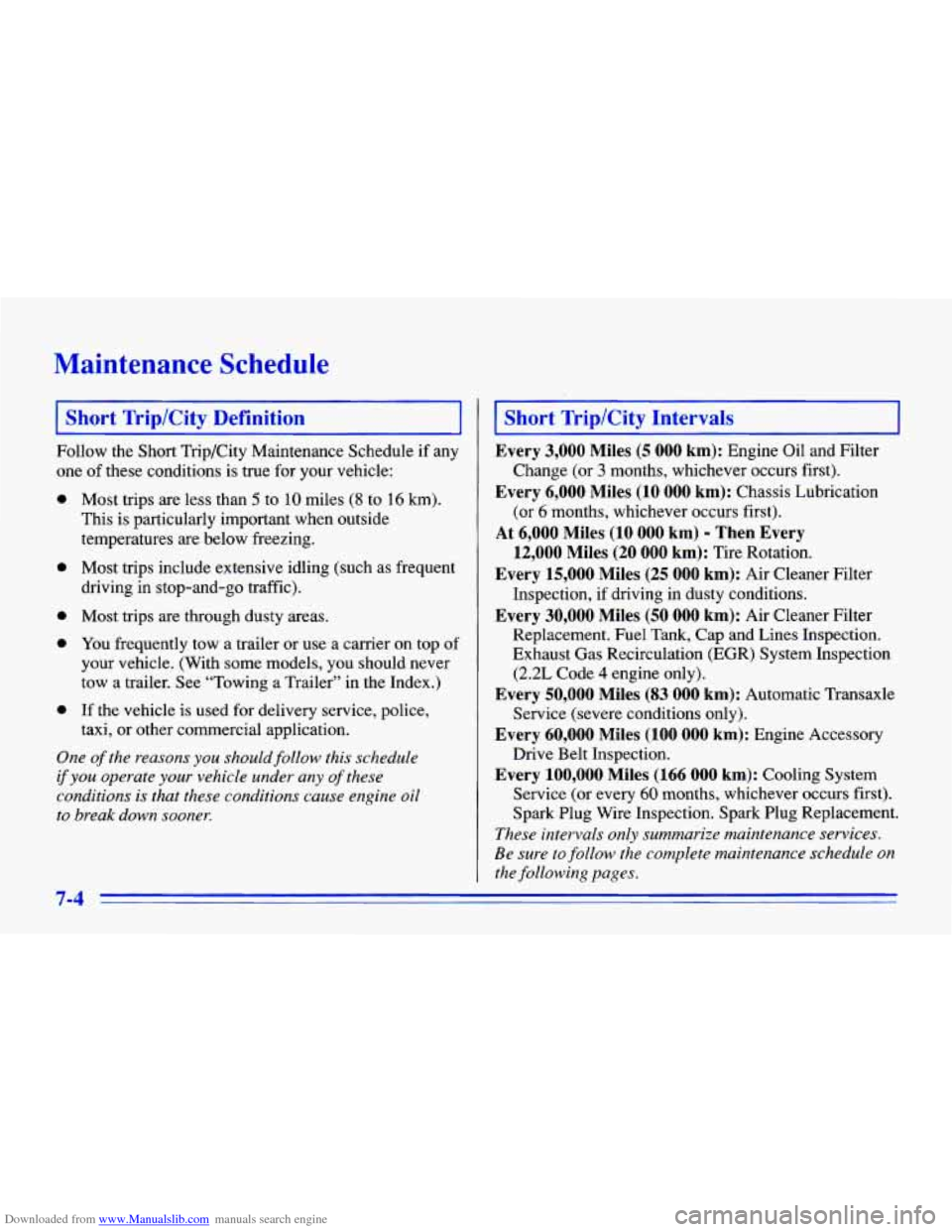
Downloaded from www.Manualslib.com manuals search engine Maintenance Schedule
I Short Trip/City Definition
~~
I
Follow the Short Trip/City Maintenance Schedule if any
one of these conditions is true for your vehicle:
0
0
e
0
e
Most trips are less than 5 to 10 miles (8 to 16 km).
This is particularly important when outside
temperatures are below freezing.
Most trips include extensive idling (such as frequent
driving in stop-and-go traffic).
Most trips
are through dusty areas.
You frequently tow
a trailer or use a carrier on top of
your vehicle. (With some models, you should never
tow a trailer. See “Towing a Trailer” in the Index.)
If the vehicle is used for delivery service, police,
taxi, or other commercial application.
One of the reasons you should follow this schedule
if you operate your vehicle under any of these
conditions is that these conditions cause engine oil
to break down sooner.
Short Trip/City Intervals
Every 3,000 Miles (5 000 km): Engine Oil and Filter
Change (or
3 months, whichever occurs first).
Every 6,000 Miles (10 000 km): Chassis Lubrication
(or
6 months, whichever occurs first).
At 6,000 Miles (10 000 km) - Then Every
12,000 Miles (20 000 km): Tire Rotation.
Every 15,000 Miles (25 000 km): Air Cleaner Filter
Inspection,
if driving in dusty conditions.
Every 30,000 Miles (50 000 km): Air Cleaner Filter
Replacement. Fuel Tank, Cap and Lines Inspection.
Exhaust Gas Recirculation (EGR) System Inspection
(2.2L Code 4 engine only).
Every 50,000 Miles (83 000 km): Automatic Transaxle
Service (severe conditions only).
Every 60,000 Miles (100 000 km): Engine Accessory
Drive Belt Inspection.
Every 100,000 Miles (166 000 km): Cooling System
Service (or every
60 months, whichever occurs first).
Spark Plug Wire Inspection. Spark Plug Replacement.
These intervals only summarize maintenance services.
Be sure to follow the complete maintenance schedule
on
the following pages.
7-4
Page 303 of 372
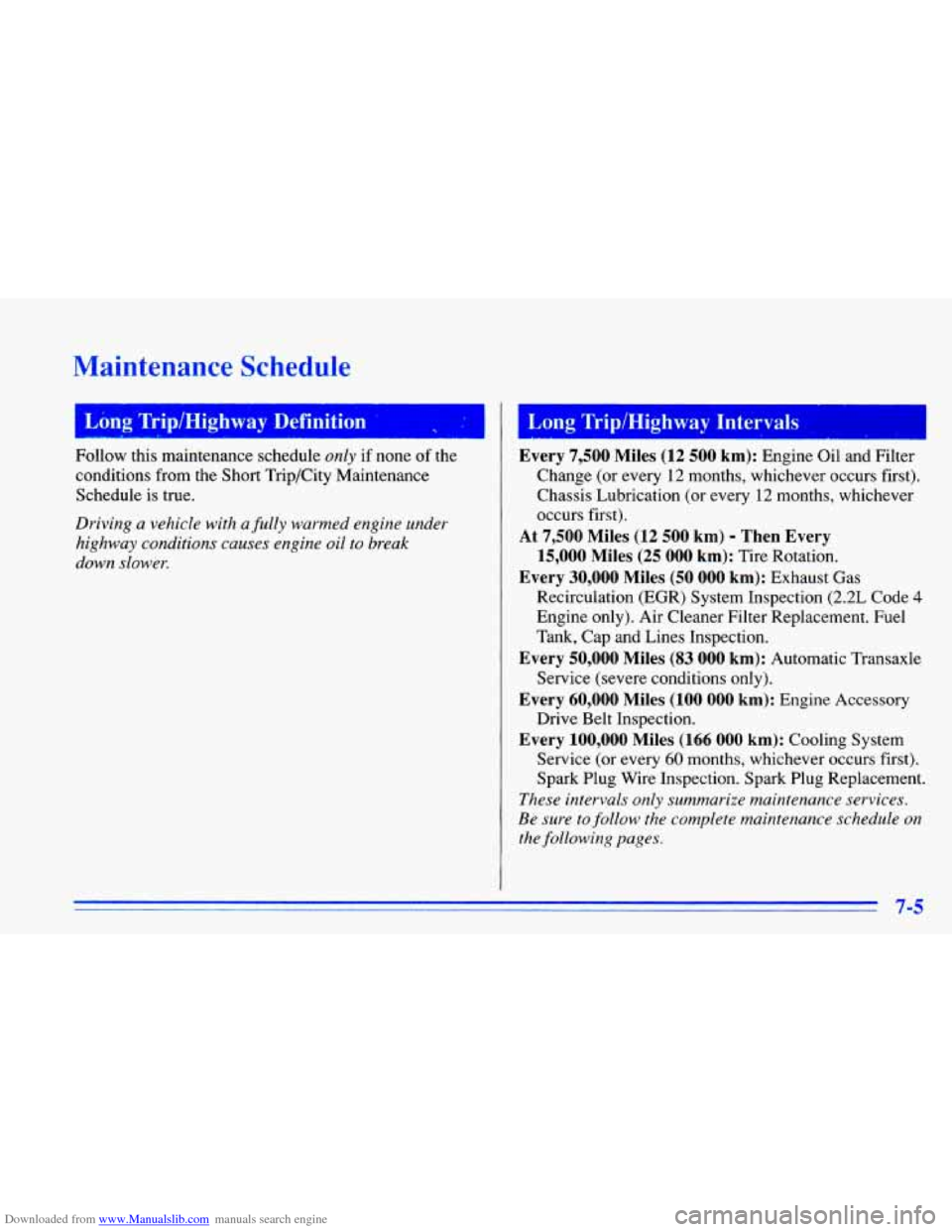
Downloaded from www.Manualslib.com manuals search engine Maintenance Schedule
Long Trip/Highway Definition h Long TriplHighway Intervals
Follow this maintenance schedule only if none of LIIG
conditions from the Short Trip/City Maintenance
Schedule is true.
Driving a vehicle with a fully warmed engine under
highway conditions causes engine oil to break
down slower.
nvery 7,500 Miles (12 500 km): Engine Oil and Filter
Change (or every
12 months, whichever occurs first).
Chassis Lubrication (or every
12 months, whichever
occurs first).
At 7,500 Miles (12 500 km) - Then Every
15,000 Miles (25 000 km): Tire Rotation.
Every 30,000 Miles (50 000 km): Exhaust Gas
Recirculation (EGR) System Inspection (2.2L Code 4
Engine only). Air Cleaner Filter Replacement. Fuel
Tank, Cap and Lines Inspection.
Every 50,000 Miles (83 000 km): Automatic Transaxle
Service (severe conditions only).
Every 60,000 Miles (100 000 km): Engine Accessory
Drive Belt Inspection.
Every 100,000 Miles (166 000 km): Cooling System
Service (or every
60 months, whichever occurs first).
Spark Plug Wire Inspection. Spark Plug Replacement.
These intervals only summarize maintenance services.
Be sure
to follow the complete maintenance schedule on
the following pages.
7-5
Page 304 of 372
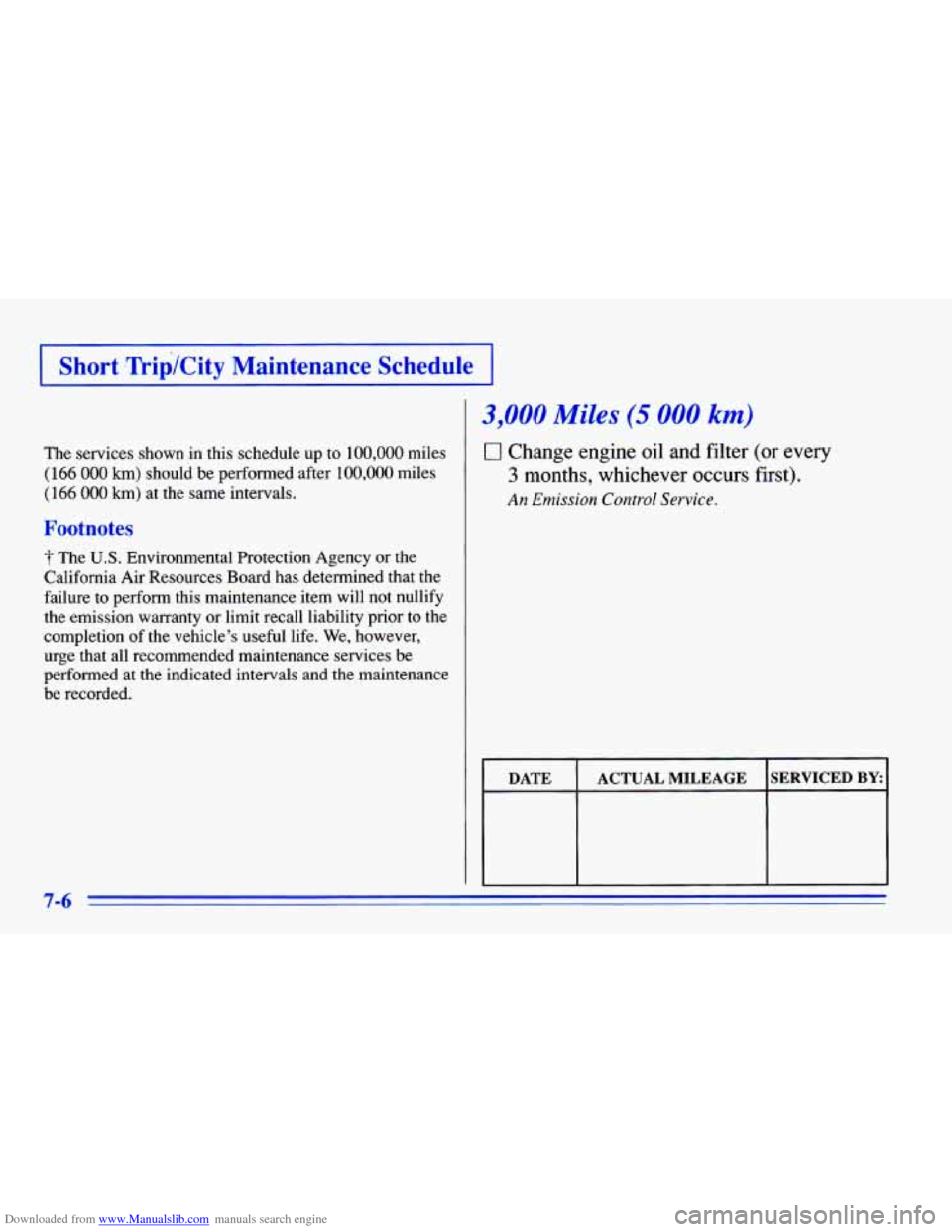
Downloaded from www.Manualslib.com manuals search engine I Short .Trip/City Maintenance Schedule I
The services shown in this schedule up to 100,000 miles
(166 000 km) should be performed after 100,000 miles
(1 66 000 km) at the same intervals.
Footnotes
The U.S. Environmental Protection Agency or the
California Air Resources Board has determined that the
failure to perform this maintenance item will not nullify
the emission warranty or limit recall liability prior
to the
completion of the vehicle’s useful life. We, however,
urge that all recommended maintenance services be
performed
at the indicated intervals and the maintenance
be recorded.
3,000 Miles (5 000 km)
0 Change engine oil and filter (or every
3 months, whichever occurs first).
An Emission Control Service.
I DATE ACTUAL MILEAGE SERVICED BY:
7-6
Page 325 of 372
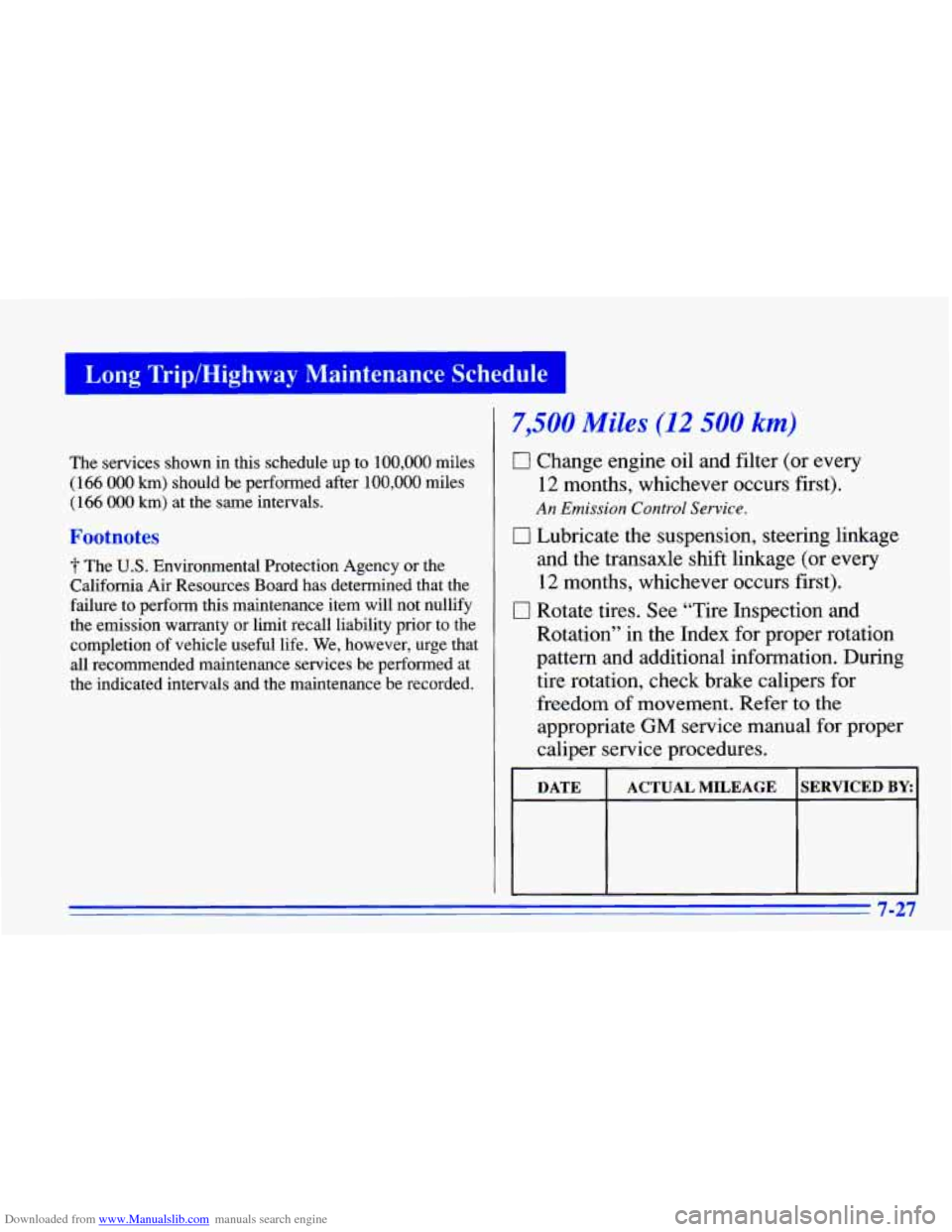
Downloaded from www.Manualslib.com manuals search engine Long Trip/Highway Maintenance Schedule
The services shown in this schedule up to 100,000 miles
(166
000 km) should be performed after 100,000 miles
(166
000 km) at the same intervals.
Footnotes
The U.S. Environmental Protection Agency or the
California Air Resources Board has determined that the
failure to perform this maintenance item will not nullify
the emission warranty or limit recall liability prior to the
completion
of vehicle useful life. We, however, urge that
all recommended maintenance services be performed
at
the indicated intervals and the maintenance be recorded.
7,500 Miles (12 500 km)
0 Change engine oil and filter (or every
12 months, whichever occurs first).
An Emission Control Service.
0 Lubricate the suspension, steering linkage
and the transaxle shift linkage (or every
12 months, whichever occurs first).
0 Rotate tires. See “Tire Inspection and
Rotation” in the Index for proper rotation
pattern and additional information. During
tire rotation, check brake calipers for
freedom of movement. Refer
to the
appropriate
GM service manual for proper
caliper service procedures.
7-27
Page 336 of 372
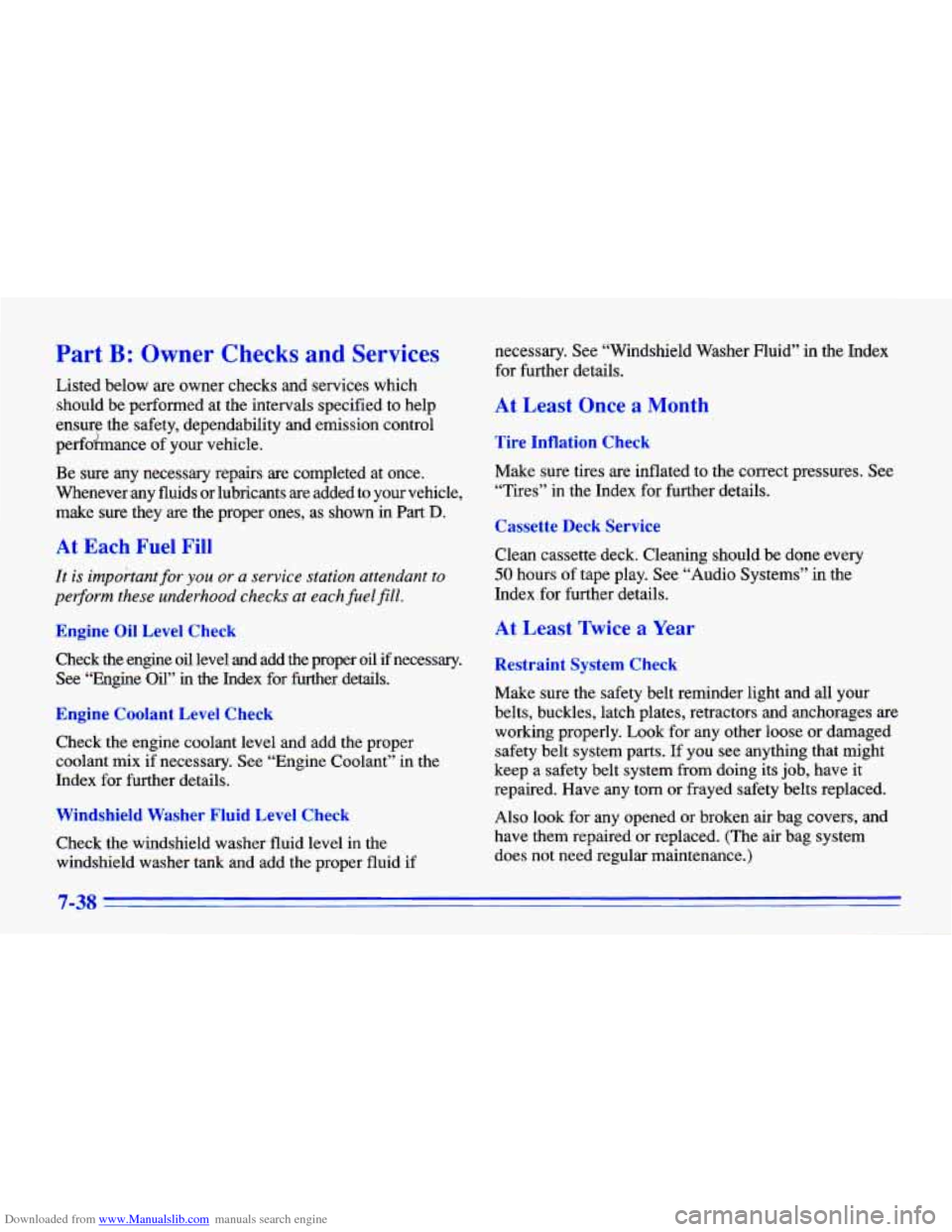
Downloaded from www.Manualslib.com manuals search engine Part B: Owner Checks and Services
Listed below are owner checks and services which
should be performed at the intervals specified to help
ensure the safety, dependability and emission control
perfoJmance of your vehicle.
Be sure any necessary repairs are completed at once.
Whenever any fluids or lubricants are added to your vehicle,
make sure they are the proper ones, as shown in
Part D.
At Each Fuel Fill
It is important for you or a service station attendant to
pe$orrn these underhood checks at each fuel fill.
Engine Oil Level Check
Check the engine oil level and add the proper oil if necessary.
See ‘Engine Oil”
in the Index for further details.
Engine Coolant Level Check
Check the engine coolant level and add the proper
coolant mix if necessary. See “Engine Coolant” in the
Index for further details.
Windshield Washer Fluid Level Check
Check the windshield washer fluid level in the
windshield washer tank and add the proper fluid if necessary.
See “Windshield Washer Fluid” in the Index
for further details.
At Least Once a Month
Tire Inflation Check
Make sure tires are inflated to the correct pressures. See
“Tires” in the Index for further details.
Cassette Deck Service
Clean cassette deck. Cleaning should be done every
50 hours of tape play. See “Audio Systems” in the
Index for further details.
At Least Twice a Year
Restraint System Check
Make sure the safety belt reminder light and all your
belts, buckles, latch plates, retractors and anchorages are
working properly. Look for any other loose or damaged
safety belt system parts.
If you see anything that might
keep a safety belt system from doing its job, have it
repaired. Have any torn or frayed safety belts replaced.
Also look for any opened or broken air bag covers, and
have them repaired or replaced. (The
air bag system
does not need regular maintenance.)
7-38
Page 343 of 372
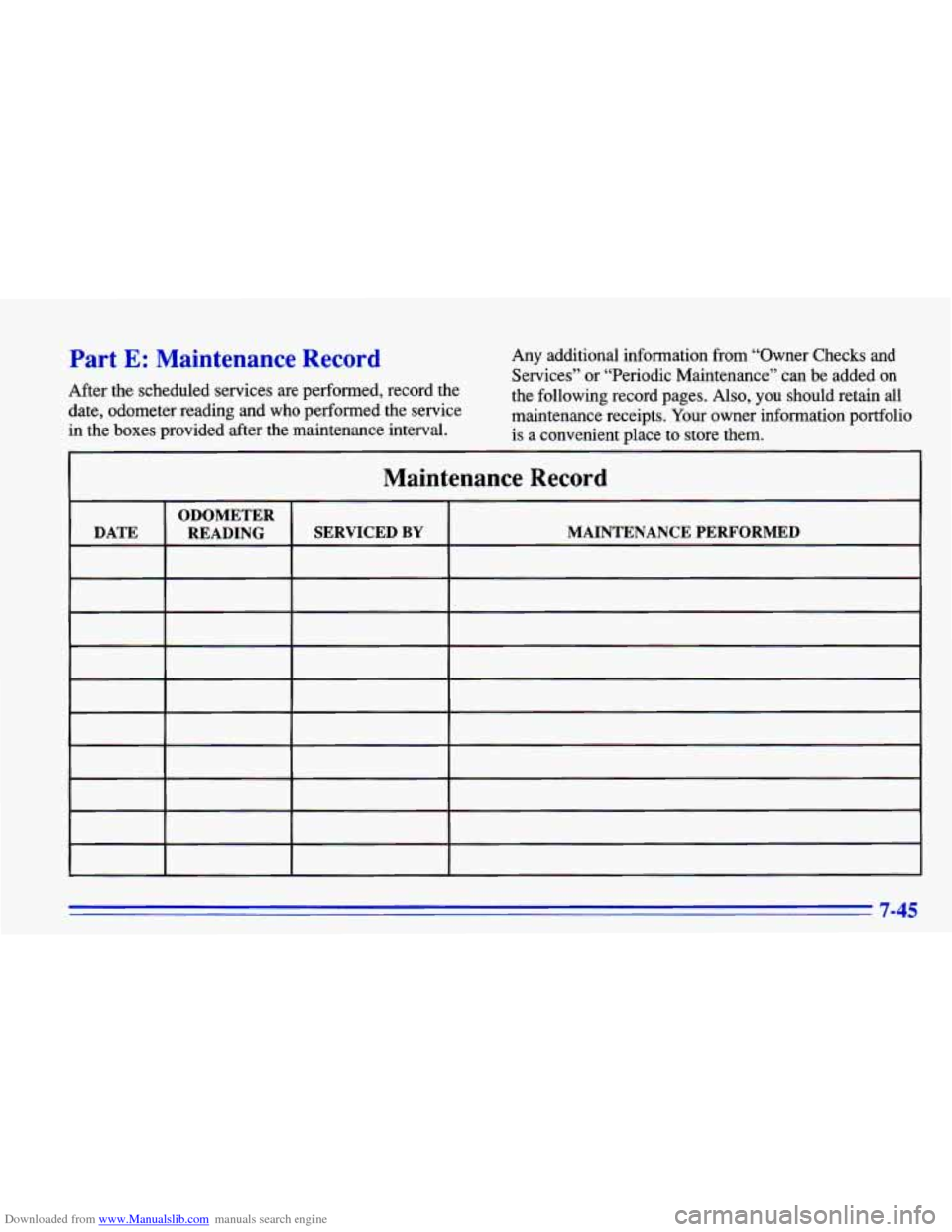
Downloaded from www.Manualslib.com manuals search engine Part E: Maintenance Record Any additional information from “Owner Checks and Services” or “Periodic Maintenance” can be added on
After the scheduled services are performed, record the the following record pages. Also, you should retain
all
date, odometer reading and who performed the service maintenance recei\
pts. Your owner information portfolio
in the boxes provided after the maintenance interval. is a convenient \
place to store them.
7-45
Page 365 of 372
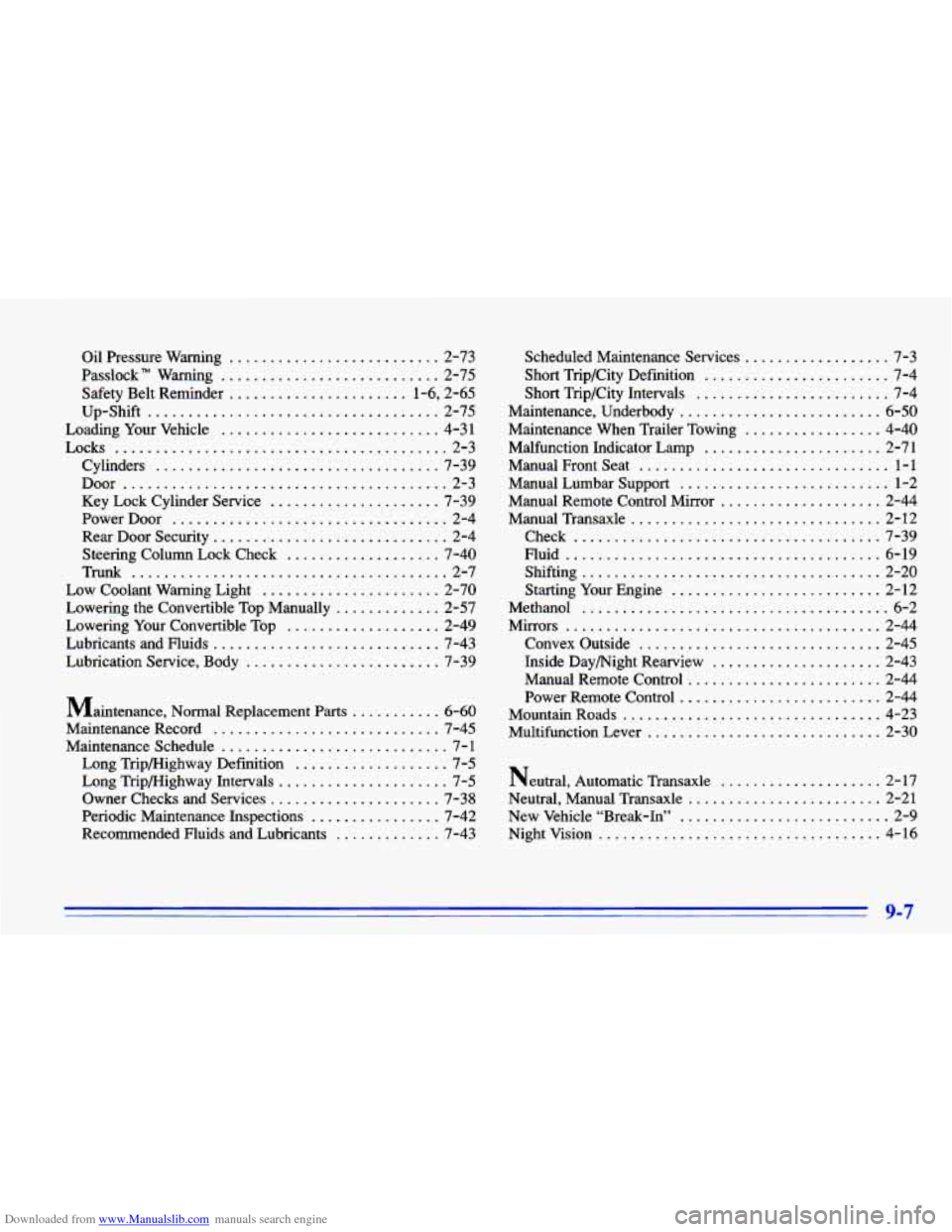
Downloaded from www.Manualslib.com manuals search engine Oil Pressure Warning .......................... 2-73
Passlock Warning
........................... 2-75
Safety Belt Reminder
...................... 1.6. 2.65
Loading Your Vehicle
........................... 4-31
Cylinders
................................... 7-39
Door
........................................ 2-3
PowerDoor
.................................. 2-4
Rear Door Security
............................. 2-4
Steering Column Lock Check
................... 7-40
Tr~nk
....................................... 2-7
Low Coolant Warning Light
...................... 2-70
Lowering the Convertible Top Manually
............. 2-57
Lowering Your Convertible Top
................... 2-49
Lubricants and Fluids
............................ 7-43
Lubrication Service. Body
........................ 7-39
Up-Shift
.................................... 2-75
Locks
......................................... 2-3
Key Lock Cylinder Service
..................... 7-39
Maintenance. Normal Replacement
parts ........... 6-60
Maintenance Record ............................ 7-45
Maintenance Schedule
............................ 7- 1
Long Tripmighway Definition ................... 7-5
Long Tripmighway Intervals
..................... 7-5
Owner Checks and Services
..................... 7-38
Periodic Maintenance Inspections
................ 7-42
Recommended Fluids and Lubricants
............. 7-43 Scheduled Maintenance Services
.................. 7-3
Short Trip/City Definition
....................... 7-4
Short Trip/City Intervals
........................ 7-4
Maintenance. Underbody
......................... 6-50
Maintenance When Trailer Towing
................. 4-40
Malfunction Indicator Lamp
...................... 2-71
Manual Front Seat
............................... 1 . 1
Manual Lumbar Support .......................... 1-2
Manual Remote Control Mirror
.................... 2-44
Manual Transaxle
............................... 2-12
Check
...................................... 7-39
Fluid
....................................... 6-19
Shifting
..................................... 2-20
Starting Your Engine
.......................... 2-12
Methanol
...................................... 6-2
Mirrors
....................................... 2-44
Convex Outside
.............................. 2-45
Inside Daymight Rearview
..................... 2-43
Manual Remote Control
........................ 2-44
Power Remote Control
......................... 2-44
MountainRoads
................................ 4-23
Multifunction Lever
............................. 2-30
Neutral. Automatic Transaxle
.................... 2-17
Neutral. Manual Transaxle
........................ 2-21
New Vehicle “Break-In”
.......................... 2-9
Nightvision
................................... 4-16
9- /